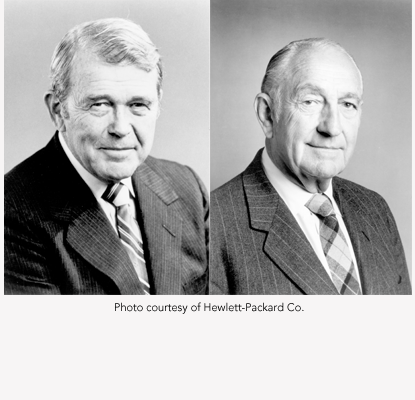William Hewlett and David Packard
"Dave and I recognized from the start that invention was the lifeblood of our community. We tried to develop an atmosphere that encourages creativity and innovation," commented William Hewlett, co-recipient of the 1995 Lemelson-MIT Lifetime Achievement Award with David Packard. Co-founders of the Hewlett-Packard Company, Hewlett and Packard changed the technological landscape with their inventions and innovations in the field of computing.
Hewlett and Packard first met as undergraduate students at Stanford University in Palo Alto, California. After graduation in 1934, Hewlett went to MIT to earn a master's degree in electrical engineering, while Packard worked at General Electric. Following these pursuits, both returned to Stanford—Hewlett to receive his degree of engineer and Packard to start a fellowship. During this time, the two were encouraged to contribute to the foundation of a technology community in the Palo Alto area, today known as Silicon Valley.
In 1939 Hewlett and Packard established their enterprise in Packard's garage. A coin toss decided their company name—the result was the Hewlett Packard Company. Their first product was a resistance capacity audio oscillator, based on Hewlett's graduate work, which Walt Disney Studios purchased to produce Fantasia.
Throughout the years, the company grew and outpaced competition through its technological innovations. Among its most notable accomplishments are the high speed frequency counter (1951)—used by radio stations to meet FCC requirements; the cesium-beam standard clock (1964)—sets international time standards; the first desktop calculator (1968); the first scientific hand-held calculator (1972); the first desktop mainframe computer (1982); and the successful HP Laserjet Printer series—a paragon in the industry.
Originating in Packard's garage with $538 and two employees, the Hewlett-Packard Company has evolved as one of the world's largest corporations, as ranked by Fortune magazine.
Hewlett was born in 1913 in Ann Arbor, Michigan. Following his duty as an army officer in World War II, Hewlett served as president (1964-1977) and chief executive officer (1969-1978) of Hewlett Packard Company. He also held other positions and last served as director emeritus. Hewlett died in 2001.
Born in Pueblo, Colorado, in 1912, Packard served as president of the Hewlett Packard Company (1947-1964), in addition to other leadership positions, culminating with chairman emeritus. In 1969 he served as deputy secretary of defense in Nixon's first administration. Packard died in 1996.
In addition to their technological innovations, Hewlett and Packard are both recognized for their service to people and the community. As philanthropists and leaders in management ethics, they fostered creativity, offered employees a range of benefits, and enriched communities.


